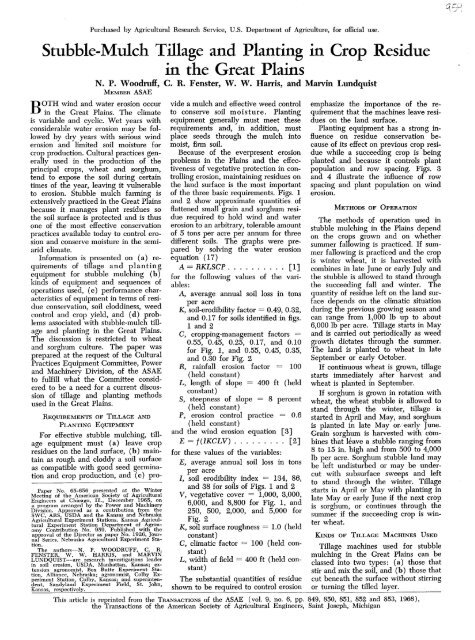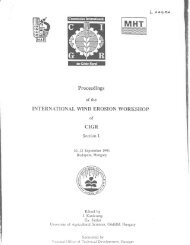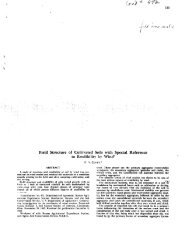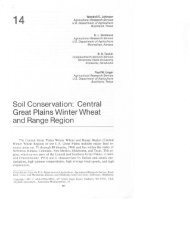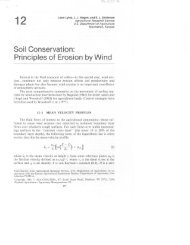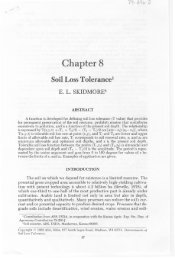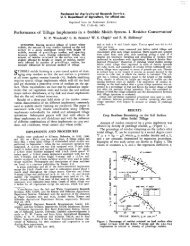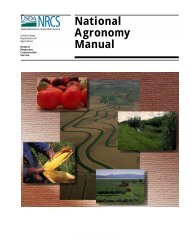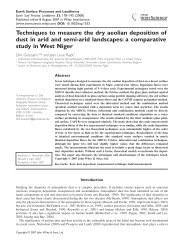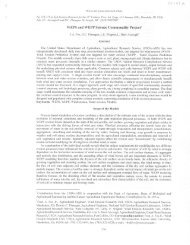Stubble-Mulch Tillage and Planting in Crop Residue - USDA-ARS ...
Stubble-Mulch Tillage and Planting in Crop Residue - USDA-ARS ...
Stubble-Mulch Tillage and Planting in Crop Residue - USDA-ARS ...
You also want an ePaper? Increase the reach of your titles
YUMPU automatically turns print PDFs into web optimized ePapers that Google loves.
Purchased by Agricultural Research Service, U.S. Department of Agriculture, for official use.<br />
<strong>Stubble</strong>-<strong>Mulch</strong> <strong>Tillage</strong> <strong>and</strong> <strong>Plant<strong>in</strong>g</strong> <strong>in</strong> <strong>Crop</strong> <strong>Residue</strong><br />
<strong>in</strong> the Great Pla<strong>in</strong>s<br />
N. P. Woodruff, C. R. Fenster, W. W. Harris, <strong>and</strong> Marv<strong>in</strong> Lundquist<br />
MEMBER ASAE<br />
OTH w<strong>in</strong>d <strong>and</strong> water erosion occur<br />
B <strong>in</strong> the ,Great Pla<strong>in</strong>s. The climate<br />
is variable <strong>and</strong> cyclic. Wet years with<br />
considerable water erosion may be followed<br />
by dry years with serious w<strong>in</strong>d<br />
erosion <strong>and</strong> limited soil moisture for<br />
crop production. Cultural practices generally<br />
used <strong>in</strong> the production of the<br />
pr<strong>in</strong>&pal crops, wheat <strong>and</strong> sorghum,<br />
tend to expose the soil dur<strong>in</strong>g certa<strong>in</strong><br />
times of the year, leav<strong>in</strong>g it vulnerable<br />
to erosion. <strong>Stubble</strong> mulch farm<strong>in</strong>g is<br />
extensively practiced <strong>in</strong> the Great ~ kns<br />
because it manages plant residues so<br />
the soil surface is protected <strong>and</strong> is thus<br />
one of the most iffective conservation<br />
practices available today to control ero-<br />
;ion <strong>and</strong> conserve moisture <strong>in</strong> the semiarid<br />
climate.<br />
Information is presented on (a) requirements<br />
of t<strong>in</strong>age an d plant i n g<br />
equipment for stubble mulch<strong>in</strong>g ( b )<br />
k<strong>in</strong>ds of equipment <strong>and</strong> sequences of<br />
operations used, (c) performance characteristics<br />
of equipment <strong>in</strong> terms of residue<br />
conservation, soil clodd<strong>in</strong>ess, weed<br />
control <strong>and</strong> crop yield, <strong>and</strong> (d) problems<br />
associated with stubble-mulch tillage<br />
<strong>and</strong> plant<strong>in</strong>g <strong>in</strong> the Great Pla<strong>in</strong>s.<br />
The discussion is restricted to wheat<br />
<strong>and</strong> sorghum culture. The paper was<br />
prepared at the request of the Cultural<br />
Practices Equipment Committee, Power<br />
<strong>and</strong> Mach<strong>in</strong>ery Division, of the ASAE<br />
to fulfill what the Committee considered<br />
to be a need for a current discussion<br />
of tillage <strong>and</strong> plant<strong>in</strong>g methods<br />
used <strong>in</strong> the Great Pla<strong>in</strong>s.<br />
For effective stubble mulch<strong>in</strong>g, tillage<br />
equipment must (a) leave crop<br />
residues on the l<strong>and</strong> surface, (b) ma<strong>in</strong>ta<strong>in</strong><br />
as rough <strong>and</strong> cloddy a soil surface<br />
as compatible with good seed germ<strong>in</strong>ation<br />
<strong>and</strong> crop production, <strong>and</strong> (c) pro-<br />
Paper No. 65-656 presented at the W<strong>in</strong>ter<br />
Meet<strong>in</strong>g of the American Society of Agricultural<br />
Eng<strong>in</strong>eers at Chicago, Ill., December 1965, on<br />
a program arranged by the Power <strong>and</strong> Mach<strong>in</strong>ery<br />
Division. Approved as a contribution from the<br />
SWC <strong>ARS</strong> <strong>USDA</strong> <strong>and</strong> the Kansas <strong>and</strong> Nebraska<br />
~gri<urai Experiment Stations. Kansas Agricultural<br />
Experiment Station Department of Agronomy<br />
Contribution No. 959. Published with the<br />
approval of the Director as paper No. 1926, Journal<br />
Series, Nebraska Agricultural Experiment Station.<br />
The authors-N. P. WOODRUFF, C. R.<br />
FENSTER W W. HARRIS <strong>and</strong> MARVIN<br />
LUNDQU~ST~~~~ research <strong>in</strong>;estigations leader<br />
<strong>in</strong> soil erosion, <strong>USDA</strong> Manhattan Kansas; exten~ion<br />
agronomist, ~ d x Butte ~x~eriment Station,<br />
Alliance, Nebraska; agronomist, Colby Experiment<br />
Station, Colby, Kansas; <strong>and</strong> super<strong>in</strong>tendent,<br />
S<strong>and</strong>yl<strong>and</strong> Experiment Field, St. John,<br />
vide a mulch <strong>and</strong> effective weed control<br />
to conserve soil m o i s t u r e . <strong>Plant<strong>in</strong>g</strong><br />
equipment generally must meet these<br />
requirements <strong>and</strong>, <strong>in</strong> addition, must<br />
place seeds through the mulch <strong>in</strong>to<br />
moist, firm soil.<br />
Because of the everpresent erosion<br />
problems <strong>in</strong> the Pla<strong>in</strong>s <strong>and</strong> the effectiveness<br />
of vegetative protection <strong>in</strong> controll<strong>in</strong>g<br />
erosion, ma<strong>in</strong>ta<strong>in</strong><strong>in</strong>g residues on<br />
the l<strong>and</strong> surface is the most important<br />
of the three basic requirements. Figs. 1<br />
<strong>and</strong> 2 show approximate quantities of<br />
flattened small gra<strong>in</strong> <strong>and</strong> sorghum residue<br />
required to hold w<strong>in</strong>d <strong>and</strong> water<br />
erosion to an arbitrary, tolerable amount<br />
of 5 tons per acre per annum for three<br />
different soils. The graphs were prepared<br />
by solv<strong>in</strong>g the water erosion<br />
equation ( 17)<br />
A = RKLSCP . . . . . . . . . . [I]<br />
for the follow<strong>in</strong>g values of the variables<br />
:<br />
A, average annual soil loss <strong>in</strong> tons<br />
per acre<br />
K, soil-erodibility factor = 0.49, 0.32,<br />
<strong>and</strong> 0.17 for soils identified <strong>in</strong> figs.<br />
1 <strong>and</strong> 2<br />
C, cropp<strong>in</strong>g-management factors =<br />
0.55, 0.45, 0.25, 0.17, <strong>and</strong> 0.10<br />
for Fig. 1, <strong>and</strong> 0.55, 0.45, 0.35,<br />
<strong>and</strong> 0.30 for Fig. 2<br />
R, ra<strong>in</strong>fall erosion factor = 100<br />
(held constant)<br />
L, length of slope = 400 ft (held<br />
constant)<br />
S, steepness of slope = 8 percent<br />
(held constant)<br />
P, erosion control practice = 0.6<br />
(held constant)<br />
<strong>and</strong> the w<strong>in</strong>d erosion equation [3]<br />
E = f (IKCLV) . . . . . . . . . P I<br />
for these values of the variables:<br />
E, average annual soil loss <strong>in</strong> tons<br />
per acre<br />
I, soil erodibility <strong>in</strong>dex = 134, 86,<br />
<strong>and</strong> 38 for soils of Figs. 1 <strong>and</strong> 2<br />
V, vegetative cover = 1,000, 3,000,<br />
6,000, <strong>and</strong> 8,800 for Fig. 1, <strong>and</strong><br />
250, 500, 2,000, <strong>and</strong> 5,000 for<br />
Fig. 2<br />
K, soil surface roughness = 1.0 (held<br />
constant)<br />
C, climatic factor = 100 (held constant)<br />
L, width of field = 400 ft (held constant)<br />
The substantial quantities of residue<br />
shown to be reauired to control erosion<br />
Kansas, respectively. A V<br />
emphasize the importance of the requirement<br />
that the mach<strong>in</strong>es leave residues<br />
on the l<strong>and</strong> surface.<br />
<strong>Plant<strong>in</strong>g</strong> equipment has a strong <strong>in</strong>fluence<br />
on residue conservation because<br />
of its effect on previous crop residue<br />
while a succeed<strong>in</strong>g crop is be<strong>in</strong>g<br />
planted <strong>and</strong> because it controls plant<br />
population <strong>and</strong> row spac<strong>in</strong>g. Figs. 3<br />
<strong>and</strong> 4 illustrate the <strong>in</strong>fluence of row<br />
spac<strong>in</strong>g <strong>and</strong> plant population on w<strong>in</strong>d<br />
erosion.<br />
The methods of operation used <strong>in</strong><br />
stubble mulch<strong>in</strong>g <strong>in</strong> the Pla<strong>in</strong>s depend<br />
on the crops grown <strong>and</strong> on whether<br />
summer fallow<strong>in</strong>g is practiced. If summer<br />
fallow<strong>in</strong>g is practiced <strong>and</strong> the crop<br />
is w<strong>in</strong>ter wheat, it is harvested with<br />
comb<strong>in</strong>es <strong>in</strong> late June or early July <strong>and</strong><br />
the stubble is allowed to st<strong>and</strong> through<br />
the succeed<strong>in</strong>g fall <strong>and</strong> w<strong>in</strong>ter. The<br />
quantity of residue left on the l<strong>and</strong> surface<br />
depends on the climatic situation<br />
dur<strong>in</strong>g the previous grow<strong>in</strong>g season <strong>and</strong><br />
can range from 1,000 lb up to about<br />
6,000 lb per acre. <strong>Tillage</strong> starts <strong>in</strong> May<br />
<strong>and</strong> is carried out periodically as weed<br />
growth dictates through the summer.<br />
The l<strong>and</strong> is planted to wheat <strong>in</strong> late<br />
September or early October.<br />
If cont<strong>in</strong>uous wheat is grown, tillage<br />
starts immediately after harvest <strong>and</strong><br />
wheat is planted <strong>in</strong> September.<br />
If sorghum is grown <strong>in</strong> rotation with<br />
wheat, the wheat stubble is allowed to<br />
st<strong>and</strong> through the w<strong>in</strong>ter, tillage is<br />
started <strong>in</strong> April <strong>and</strong> May, <strong>and</strong> sorghum<br />
is planted <strong>in</strong> late May or- early June.<br />
Gra<strong>in</strong> sorghum is harvested with c6mb<strong>in</strong>es<br />
that leave a stubble rang<strong>in</strong>g from<br />
8 to 15 <strong>in</strong>. high <strong>and</strong> from 500 to 4,000<br />
Ib per acre. Sorghum stubble l<strong>and</strong> may<br />
be left undisturbed or may be undercut<br />
with subsurface sweeps <strong>and</strong> left<br />
to st<strong>and</strong> through the w<strong>in</strong>ter. <strong>Tillage</strong><br />
starts <strong>in</strong> April or May with plant<strong>in</strong>g <strong>in</strong><br />
late May or early June if the next crop<br />
is sorghum, or cont<strong>in</strong>ues through the<br />
summer if the succeed<strong>in</strong>g crop is w<strong>in</strong>ter<br />
wheat.<br />
<strong>Tillage</strong> mach<strong>in</strong>es used for stubble<br />
mulch<strong>in</strong>g <strong>in</strong> the Great Pla<strong>in</strong>s can be<br />
classed <strong>in</strong>to two types: (a) those that<br />
stir <strong>and</strong> mix the soil, <strong>and</strong> (b) those that<br />
cut beneath the surface without stirr<strong>in</strong>g<br />
or turn<strong>in</strong>g: the tilled layer.<br />
This article is repr<strong>in</strong>ted from the TRANSACTIONS of the ASAE (vol. 9, no. 6, pp. 849, 850, 851, 852 <strong>and</strong> 853, 1966),<br />
the Transactions of the American Society of Agricultural Eng<strong>in</strong>eers, Sa<strong>in</strong>t Joseph, Michigan
RESIDUE REQUIRED<br />
WIND-> 925 .Lbs./A. 1600 Lbs./A. 2125 Lbs.1~.<br />
Stlts 8 2 Ls"aonrYf<strong>in</strong>e<br />
I<br />
I<br />
I<br />
I<br />
RESIWE REQUIRED<br />
RESI W E REQUIRED<br />
I<br />
I<br />
RESIDUE REQUIRED !<br />
I<br />
1 1<br />
I 1 I 1 I 1 I<br />
0 1OOO 2000 3000 4000 5000 6000 7000<br />
RESIDUE IN LBS/A.<br />
.II I L<br />
0 000 2000 3000<br />
RESIDUE IN LBS. /A.<br />
FIG. 1 Approximate quantities of small gra<strong>in</strong> residues required<br />
to hold erosion to an arbitrary tolerable amount of 5 tons per<br />
acre per year under the slope, soil, <strong>and</strong> vegetative conditions<br />
specified <strong>in</strong> areas with w<strong>in</strong>d erosion climatic <strong>and</strong> ra<strong>in</strong>fall erosion<br />
factors equal to 100.<br />
Stirr<strong>in</strong>g or mix<strong>in</strong>g mach<strong>in</strong>es <strong>in</strong>clude:<br />
One-way disks<br />
T<strong>and</strong>em disk harrows<br />
Offset disks<br />
Field cultivators<br />
Chisel plows<br />
Chisel plows with rodweeder attachments<br />
Rotary hoes<br />
Skew or mulch treaders<br />
Subsurface mach<strong>in</strong>es <strong>in</strong>clude :<br />
Straight blades<br />
Rigid-frame V-sweeps<br />
Flexible-frame V-sweeps<br />
Rodweeders with semichisels or<br />
shovels<br />
Pla<strong>in</strong> rodweeders.<br />
Major types of planters used to plant<br />
small gra<strong>in</strong>s <strong>in</strong> mulch <strong>in</strong>clude semideepfurrow,<br />
s<strong>in</strong>gle- <strong>and</strong> double-disk drills;<br />
deep-furrow drills with shovel-, shoe-,<br />
or hoe-type openers, <strong>and</strong> seed<strong>in</strong>g attachment<br />
on one-ways <strong>and</strong> cultivators.<br />
Row crops are planted <strong>in</strong> mulch with<br />
surface planters equipped with furrow<br />
openers, listers operated at shallow<br />
depths, till-planters, see d<strong>in</strong>g attach -<br />
ments on cultivators <strong>and</strong> one-ways, <strong>and</strong><br />
sometimes with small gra<strong>in</strong> drills with<br />
part of the seed spouts plugged to give<br />
desired spac<strong>in</strong>g.<br />
<strong>Tillage</strong><br />
The particular tillage mach<strong>in</strong>es used<br />
<strong>and</strong> the sequences <strong>in</strong> which they are<br />
used vary widely <strong>in</strong> the Pla<strong>in</strong>s. Generally,<br />
<strong>in</strong> till<strong>in</strong>g summer-fallow wheat<br />
stubble, about four operations at approximately<br />
1-month <strong>in</strong>tervals are required<br />
for weed control. The <strong>in</strong>itial<br />
tillage, <strong>in</strong> April or May, usually is accomplished<br />
with a one-way disk or a<br />
large V-sweep m a c h i n e . Subsequent<br />
cultivations may be with the same mach<strong>in</strong>es,<br />
but oftener small (32-<strong>in</strong>.)<br />
V-sweeps, rodweeders with shovels, or<br />
chisels <strong>and</strong> pla<strong>in</strong> rodweeders are used<br />
for the second, third, <strong>and</strong> fourth operations.<br />
Each k<strong>in</strong>d of mach<strong>in</strong>e available<br />
for stubble mulch tillage has a different<br />
effect on residue conservation, soil<br />
clodd<strong>in</strong>ess, <strong>and</strong> weed control, all of<br />
which <strong>in</strong> turn affect crop yield.<br />
<strong>Residue</strong> Conservation Several <strong>in</strong>vestigators<br />
(1, 2, 6, 20, 21) have evaluated<br />
residue conservation characteristics of<br />
FIG. 2 Approximate quantities or sorghum residues required to<br />
hold erosion to an arbitrary tolerable amount of 5 tons per acre<br />
per year under the slope, soil, <strong>and</strong> vegetative conditions specified<br />
<strong>in</strong> areas with w<strong>in</strong>d erosion climatic <strong>and</strong> ra<strong>in</strong>fall erosion factors<br />
equal to 100.<br />
different mach<strong>in</strong>es commonly used for<br />
stubble mulch<strong>in</strong>g <strong>in</strong> small gra<strong>in</strong> residue<br />
<strong>in</strong> the Pla<strong>in</strong>s. Table 1 presents a composite<br />
of the results. The wide variations<br />
<strong>in</strong> the data are due to the amount<br />
of residue conserved on the l<strong>and</strong> surface<br />
by the implements depend<strong>in</strong>g on<br />
factors related to the residue itself such<br />
as height <strong>and</strong> length of stubble, amount<br />
of pretillage residue dur<strong>in</strong>g <strong>in</strong>itial operations<br />
(Table 2) <strong>and</strong> previous position<strong>in</strong>g<br />
or orientation of residue (Table 3)<br />
<strong>and</strong> on factors relat<strong>in</strong>g to the implements,<br />
such as speed <strong>and</strong> depth of<br />
operation, angle <strong>and</strong> concavity of disks,<br />
<strong>and</strong> width, pitch, <strong>and</strong> angle of sweep<br />
blades. The data of Table 4 take <strong>in</strong>to<br />
account effects of these factors <strong>and</strong><br />
present <strong>in</strong>formation on the quantity of<br />
TABLE 1. RESIDUE MAINTAINED WITH TILLAGE IMPLEMENTS*<br />
Type of implement<br />
Average ma<strong>in</strong>ta<strong>in</strong>ed<br />
after each tillage<br />
o~eration<br />
Range<br />
ma<strong>in</strong>ta<strong>in</strong>ed?<br />
Percent<br />
Percent<br />
Subsurface implements:<br />
Blades (36 <strong>in</strong>. or wider) 90 70 to 113<br />
Sweeps (24 <strong>in</strong>. to 36 <strong>in</strong>.) 90 60 to 112<br />
Rodweeders-pla<strong>in</strong> rod 90 80 to 115<br />
Rodweeders-with semichisels 85 55 to 105<br />
Mix<strong>in</strong>g implements:<br />
Heavy-duty cultivator (16 <strong>in</strong>. to 18 <strong>in</strong>. sweeps) 80 50 to 100<br />
Heavy-duty cultivator (2 <strong>in</strong>. chisels 12 <strong>in</strong>. apart) 75 -.--.---..----.-<br />
One-way disk (24 <strong>in</strong>. to 26 <strong>in</strong>. pans) 50 30 to 90<br />
T<strong>and</strong>em or offset disks 50 .--.--.........-<br />
* Data from Anderson (1, 2). Woodruff <strong>and</strong> Chepil (20), Fenster (6), <strong>and</strong> Woodruff et al. (21).<br />
'r Ma<strong>in</strong>tenance values greater than 100 percent mean that more residue was brought to the surface<br />
than was buried.<br />
TABLE 2. EFFECTS OF DIFFERENT HEIGHTS AND AMOUNTS OF WHEAT STUBBLE<br />
RESIDUE ON PERCENTAGES RETAINED AFTER TILLAGE*<br />
Percentage reta<strong>in</strong>ed cm surface with stubble height of:<br />
Pretillage<br />
stubble, 12 <strong>in</strong>. 18 <strong>in</strong>.<br />
lb/a<br />
One-wav 8 ft V-sweev 2 <strong>in</strong>. chisel One-wav 8 ft V-swem 2 <strong>in</strong>. chisel<br />
* Data from Woodruff et a1 (21).
TABLE 3. EFFECTS OF ORIENTATION AND<br />
PREVIOUS POSITIONING OF RESIDUE ON<br />
PERCENTAGES RETAINED AFTER<br />
CULTIVATION TILLAGE*<br />
Implement<br />
Previous position<strong>in</strong>g<br />
Mix<strong>in</strong>g Subsurface<br />
Percent conserved<br />
32 <strong>in</strong>. sweeps 110 86<br />
Rodweeder with shovels 102 100<br />
8 ft V-sweep 93 116<br />
Pla<strong>in</strong> rodweeder 88 85<br />
One-way disk 70 53<br />
-<br />
* Data from Woodruff et a1 (21).<br />
TABLE 4. PERCENTAGES AND QUANTITIES<br />
OF WHEAT RESIDUE CONSERVED FOL-<br />
LOWING FOUR DIFFERENT SUMMER-<br />
FALLOW TILLAGE SEQUENCES AT<br />
ALLIANCE, NEBR.*<br />
<strong>Tillage</strong> sequence<br />
Operation Mach<strong>in</strong>e used<br />
0 Pretillage<br />
1 One-way<br />
2 8 ft V-sweep<br />
3 32 <strong>in</strong> sweeps<br />
4 Rodweeder<br />
0 Pretillage<br />
1 8 ft V-sweep<br />
2 32 <strong>in</strong>. sweeps<br />
3 Rodweeder<br />
4 Rodweeder<br />
<strong>Residue</strong> rema<strong>in</strong><strong>in</strong>g<br />
after operation<br />
Percent of Amount,<br />
pretillage lb per acre<br />
100 3600<br />
55 1980<br />
51 1845<br />
53 1910<br />
42 1510<br />
100 3600<br />
76 2735<br />
66 2375<br />
61 2195<br />
57 2050<br />
0 Pretillage 100 3600<br />
1 2 <strong>in</strong>. chisels 67 2410<br />
2 32 <strong>in</strong>. sweeps 61 2195<br />
3 Rodweeder 63 2270<br />
4 Rodweeder 59 2120<br />
0 Pretillage 100 3600<br />
1 One-way 55 1980<br />
2 One-way 39 1405<br />
3 32 <strong>in</strong>. sweeps 43 1550<br />
4 Rodweeder 37 1330<br />
* Data from Fenster et a1 (8).<br />
residue that four different, commonly<br />
used sequences of tillage could be expected<br />
to conserve.<br />
<strong>Tillage</strong> mach<strong>in</strong>e effects on sorghum<br />
residue conservation have not been<br />
studied as extensively as small gra<strong>in</strong><br />
residues. Research at Akron, Colo (7),<br />
<strong>and</strong> Manhattan, Kansas ( IS), <strong>in</strong>vestigated<br />
the effect of fall as opposed to<br />
spr<strong>in</strong>g tillage of sorghum residue. The<br />
Colorado studies showed no advantage<br />
<strong>and</strong> many disadvantages for fall tillage<br />
<strong>in</strong> areas where w<strong>in</strong>d erosion is critical.<br />
However, the Kansas studies showed<br />
that fall disk<strong>in</strong>g of sorghum stubble <strong>in</strong>creased<br />
st<strong>and</strong>s <strong>and</strong> gra<strong>in</strong> yields. The<br />
Colorado <strong>in</strong>vestigation show e d that<br />
amounts of sorghum residue were reduced<br />
by 31 to 34 percent by w<strong>in</strong>ter<br />
weather<strong>in</strong>g, which was about equal to<br />
the reduction caused by tillage mach<strong>in</strong>es<br />
(Table 5).<br />
Soil Clodd<strong>in</strong>ess Research on the effects<br />
of stubble-mulch tillage implements<br />
on surface soil clodd<strong>in</strong>ess has<br />
produced extremely vary<strong>in</strong>g results. The<br />
clodd<strong>in</strong>ess that will be produced by<br />
0<br />
10 20 30 40 50<br />
ROW<br />
SPACING (INCHES)<br />
FIG. 3 Effect of row spac<strong>in</strong>g on soil loss<br />
as measured with a portable w<strong>in</strong>d tunnel<br />
parallel <strong>and</strong> perpendicular to row direction.<br />
Skidmore et a1 (16).<br />
any given implement is ma<strong>in</strong>ly determ<strong>in</strong>ed<br />
by the soil moisture <strong>and</strong> density<br />
at tillage <strong>and</strong> the force pattern of the<br />
particular tillage po<strong>in</strong>t (12, 13). Measurements<br />
of soil clodd<strong>in</strong>ess after <strong>in</strong>itial<br />
tillage of undisturbed wheat-stubble<br />
l<strong>and</strong>-produced the results shown <strong>in</strong> Fig.<br />
5, but generally it has not been possible<br />
to f<strong>in</strong>d any significant difference <strong>in</strong><br />
clodd<strong>in</strong>ess produced by different implements<br />
o; different sdquences of implements<br />
<strong>in</strong> subsequent tillage (8, 11,<br />
19, 20).<br />
Weed control The degree of stirr<strong>in</strong>g<br />
action, the temperature, the soil water<br />
content, the k<strong>in</strong>d of weeds present, <strong>and</strong><br />
the stage of growth all <strong>in</strong>fluence weed<br />
control atta<strong>in</strong>able with any tillage mach<strong>in</strong>e<br />
( 11 ). There is considerable variation<br />
<strong>in</strong> control between years for the<br />
same implement, but generally better<br />
weed control is obta<strong>in</strong>ed with implements<br />
that <strong>in</strong>vert <strong>and</strong> mix the top soil<br />
layer such as one-way disks, than with<br />
subsurface sweeps (6, 7, 11, 20, 23).<br />
Table 6 shows the weed control obta<strong>in</strong>ed<br />
<strong>in</strong> Nebraska by <strong>in</strong>itial tillage<br />
with five different implements.<br />
Cheatgrass <strong>and</strong> downy brome are<br />
particularly troublesome weeds with<br />
stubble mulch<strong>in</strong>g <strong>in</strong> the w<strong>in</strong>ter wheat<br />
areas ( 14) . Cheatgrass population is<br />
<strong>in</strong>fluenced by methods of tillage <strong>and</strong><br />
by cropp<strong>in</strong>g systems. Studies at A%-<br />
ance, Nebraska, showed significantly<br />
better control of downy brome with tillage<br />
sequences us<strong>in</strong>g a one-way disk <strong>in</strong><br />
comb<strong>in</strong>ation with sweep implements<br />
than with sequences employ<strong>in</strong>g sweeps<br />
exclusively (Table 7). Research at St.<br />
TABLE 5. EFFECTS OF FIVE DIFFERENT TILUGE SEQUEN2ES ON SORGHUM RESIDUE<br />
MANAGEMENT AT AKRON, COLO.<br />
<strong>Tillage</strong> implement <strong>and</strong> date used<br />
<strong>Residue</strong> rema<strong>in</strong><strong>in</strong>g<br />
September 2 at<br />
May 16 June 12 MY 6 August 3 end of fallowt<br />
Percent<br />
Rodweeder with shovels Ro+veeder with shovels 48 <strong>in</strong>. sweeps Rodweeder 45<br />
48 <strong>in</strong>. sweeps 48 <strong>in</strong>. sweeps 48 <strong>in</strong>. sweeps Rodweeder 41<br />
Chisels Chisels 48 <strong>in</strong>. sweeps Rodweeder 36<br />
One-way One-way 48 <strong>in</strong>. sweeps Rodweeder 21<br />
T<strong>and</strong>em disk T<strong>and</strong>em disk 48 <strong>in</strong>. sweeps Rodweeder 17<br />
* Data from Greb <strong>and</strong> Black (9).<br />
t Pretillage residue amounted to 860 lb per acre May 16 after a 34-percent loss dur<strong>in</strong>g w<strong>in</strong>ter.<br />
TABLE 6. WEED CONTROL OBTAINED ON<br />
TWO DIFFERENT YE<strong>ARS</strong> AT ALLIANCE,<br />
NEBR., BY INITIAL TILLAGE OF WHEAT<br />
STUBBLE WITH FIVE INDICATED<br />
IMPLEMENTS*<br />
Implement<br />
Percent control<br />
1961 1959<br />
One-way disk 99 88<br />
Two-<strong>in</strong>ch chisels 83 87<br />
Rodweeder with shovels 47 80<br />
Eight-foot V-sweep 44 80<br />
32 <strong>in</strong>. V-svee~s 41 63<br />
* Data from Fenster et a1 (8).<br />
TABLE 7. EFFECT OF TILLAGE SEQUENCE<br />
IN 1961 ON RESULTANT DOWNY BROME<br />
POPULATION IN WHEAT CROP IN MAY<br />
1962 AT ALLIANCE. NEBR.Q<br />
Average number of<br />
plants per 12-ft strip$<br />
N-S-RW-RW 162<br />
N-S-S-RW 113<br />
N-OW-S-RW 62<br />
OW-CH-S-RW 47<br />
OW-OW-S-RW 26<br />
* Data from Fenster et a1 (8).<br />
7 N, 8 ft V-sweep; S, 32 <strong>in</strong>. V-sweeps; RW,<br />
pla<strong>in</strong> rodweeder; OW, one-way disk; CH, rodweeder<br />
with shovels.<br />
S Twelve-foot strip between 14-<strong>in</strong>. drill rows.<br />
John, Kansas", <strong>in</strong>dicates that a serious<br />
cheatgrass problem develops <strong>in</strong> cont<strong>in</strong>uous<br />
wheat on s<strong>and</strong>y stubblemulched<br />
l<strong>and</strong> but it presents essentially<br />
no problem when the l<strong>and</strong> was summer<br />
fallowed between wheat crops or if a<br />
wheat-cowpea rotation is followed.<br />
<strong>Crop</strong> Yields Results from studies to<br />
evaluate the effects of tillage on crop<br />
yields have varied. Some <strong>in</strong>vestigators<br />
(15) have reported higher yields on<br />
l<strong>and</strong> tilled with subsurface sweeps than<br />
on l<strong>and</strong> tilled with disks or plows. Others<br />
(4) have reported higher yields on<br />
one-wayed l<strong>and</strong> than on subsurfacesweep<br />
tilled l<strong>and</strong>. Z<strong>in</strong>gg <strong>and</strong> Whitfield<br />
(23) summarized stubble-mulch farm<strong>in</strong>g<br />
results <strong>in</strong> the western states <strong>and</strong><br />
concluded that the trend is for stubble<br />
mulch<strong>in</strong>g to yield more than clean<br />
tillage when the climate is semiarid <strong>and</strong><br />
less than clean tillage when the climate<br />
is subhumid.<br />
Exam<strong>in</strong>ation of year-to-year effects<br />
of tillage on w<strong>in</strong>ter wheat yields <strong>in</strong>dicates<br />
that yields are generally related<br />
to weed control <strong>and</strong> to soil moisture at<br />
time of plant<strong>in</strong>g. Table 8 shows yield<br />
data for five different four-operation<br />
tillage sequences for a dry year ( 1961 )<br />
<strong>and</strong> a relatively wet year (1962). Soil<br />
moisture was extremely critical at plant<strong>in</strong>g<br />
time <strong>in</strong> 1961 but was not <strong>in</strong> 1962.<br />
As a result, yields were sharply reduced<br />
<strong>in</strong> 1861 on l<strong>and</strong> tilled with sweeps,<br />
which gave poor weed control. However,<br />
there was no significant difference<br />
<strong>in</strong> yields <strong>in</strong> 1962 when soil moisture<br />
was not critical even though weed control<br />
on subsurface-sweep-tilled l<strong>and</strong> was<br />
poor.<br />
<strong>Plant<strong>in</strong>g</strong><br />
Quantitative data on the performance<br />
characteristics of plant<strong>in</strong>g m a c h i n e s<br />
* Annual report (1964), S<strong>and</strong>yl<strong>and</strong> Experiment<br />
Field, St. J O ~ Kans. , (Kansas Agricultural<br />
Experiment Station).
TABLE 8. WINTER WHEAT YIELDS IN<br />
RELATION TO TILLAGE SEQUENCE<br />
FOR A DRY (1961) AND A WET (1962)<br />
YEAR AT ALLIANCE, NEBR.* ,<br />
<strong>Tillage</strong> sequencet<br />
Yield, lb per acre<br />
1961 1962<br />
OW-OW-S-RW 1902 2426<br />
OW-N-S-RW 1404 2334<br />
N-OW-S-RW 1212 2406<br />
S-S-RW-RW 648 2082<br />
N-S-S-RW 414 2142<br />
* Data from Fenster et a1 (8).<br />
t OW, one-way disk; S, 32 <strong>in</strong>. V-sweeps, RW,<br />
pla<strong>in</strong> rodweeder; N, 8 ft V-sweep.<br />
used <strong>in</strong> the Pla<strong>in</strong>s are meager, especially<br />
on small gra<strong>in</strong> drills. Comparisons<br />
of an 8-<strong>in</strong>-row space, s<strong>in</strong>gle-disk drill,<br />
a 10-<strong>in</strong>.-row space hoe drill equipped<br />
with closed-type packer wheels, <strong>and</strong> a<br />
12-<strong>in</strong>. row space semideep-furrow drill<br />
at St. John, Kansas", showed that<br />
wheat yields from the hoe drill plant<strong>in</strong>g~<br />
were consistently <strong>and</strong> significantly<br />
higher than from plant<strong>in</strong>gs with the<br />
other drills. Observation <strong>and</strong> experience<br />
<strong>in</strong>dicates that semideep-furrow, s<strong>in</strong>gledisk<br />
drills, <strong>and</strong> deep-furrow drills with<br />
shovel, shoe, or hoe-type openers are<br />
most satisfactory for drill<strong>in</strong>g <strong>in</strong> stubble<br />
mulch (10). Such <strong>in</strong>novations as V<br />
notches <strong>in</strong> the openers to permit moist<br />
soil to flow <strong>in</strong>to the furrow <strong>and</strong> cover<br />
the seed, use of large rubber wheels<br />
<strong>and</strong> hydraulic hitches to lower draft<br />
<strong>and</strong> reduce side slipp<strong>in</strong>g, chrome plat<strong>in</strong>g<br />
of shovels to give lighter draft <strong>and</strong><br />
better clear<strong>in</strong>g of mulch, <strong>and</strong> use of<br />
closed- rather than open-type packer<br />
wheels all have improved the performance<br />
of small gra<strong>in</strong> drills.<br />
Row crops have been most successfully<br />
planted <strong>in</strong> mulch with surface<br />
planters equipped with furrow openers,<br />
listers operated at a shallow depth, <strong>and</strong><br />
till-planters. Fairbanks et a1 (5) compared<br />
till-planter, plow-plant, lister, <strong>and</strong><br />
surface planter methods of grow<strong>in</strong>g<br />
corn <strong>and</strong> sorghum <strong>and</strong> reported no significant<br />
difference <strong>in</strong> yield among methods,<br />
more lodg<strong>in</strong>g with the till-planter,<br />
<strong>and</strong> better residue placement <strong>and</strong> more<br />
effective erosion control with the tillplanter.<br />
Sticker et a1 (18) studied the<br />
effects of press wheels on row-crop<br />
planters <strong>and</strong> found 8, 23, <strong>and</strong> 34 percent<br />
<strong>in</strong>creases <strong>in</strong> sorghum st<strong>and</strong>s, respectively,<br />
for seed-firm, drive press,<br />
<strong>and</strong> seed-firm with drive press wheels.<br />
The ma<strong>in</strong> problems associated with<br />
stubble-mulch tillage <strong>and</strong> plant<strong>in</strong>g <strong>in</strong><br />
crop residue are: (a) mach<strong>in</strong>e operat<strong>in</strong>g<br />
difficulties, i.e., clogg<strong>in</strong>g, adjustments,<br />
<strong>and</strong> drill<strong>in</strong>g <strong>and</strong> plant<strong>in</strong>g<br />
through bunched residues, (b) weed<br />
control, (c) preserv<strong>in</strong>g sufficient residue<br />
to control erosion when residues are<br />
meager, (d) toxic effects of mulch, <strong>and</strong><br />
(e) possible <strong>in</strong>sert <strong>and</strong> plant disease.<br />
<strong>Tillage</strong>-mach<strong>in</strong>e operat<strong>in</strong>g difficulties<br />
can be lessened if great care <strong>and</strong> pa-<br />
tience are exercised <strong>in</strong> mak<strong>in</strong>g adjustments,<br />
us<strong>in</strong>g weights, select<strong>in</strong>g tillage<br />
po<strong>in</strong>ts, <strong>and</strong> <strong>in</strong> operat<strong>in</strong>g at correct<br />
speeds <strong>and</strong> depths. Experience has also<br />
shown that fewer problems will be encountered<br />
if the tillage equipment has<br />
the follow<strong>in</strong>g desirable functional <strong>and</strong><br />
design features :<br />
~ae~uate vertical spac<strong>in</strong>g between<br />
frame <strong>and</strong> tillage po<strong>in</strong>t - m<strong>in</strong>imum of<br />
18 to 20 <strong>in</strong>.<br />
Adequate horizontal spac<strong>in</strong>g between<br />
st<strong>and</strong>ards - m<strong>in</strong>imum of 24 <strong>in</strong>.<br />
Effective coulter action - m<strong>in</strong>imum<br />
diameter 18 to 20 <strong>in</strong>.<br />
Proper tillage po<strong>in</strong>t design - 60 to<br />
70-deg V angles with 37-deg pitch on<br />
subsurface sweeps - 24-<strong>in</strong>. diameters<br />
with 3-<strong>in</strong>. concavity on disks.<br />
Correct speeds of operation - 4 to 5<br />
mph best for most implements.<br />
Adequate depth adjustments preferable<br />
with hydraulic controls <strong>and</strong> depthgage<br />
wheels.<br />
Adequate disk-angle adjustments.<br />
Flexible implement frames <strong>and</strong><br />
widths-5 to 8-ft sections desirable for<br />
better performance on uneven l<strong>and</strong>.<br />
Availability of a variety of adaptable<br />
equipment to regulate amounts of residue<br />
conserved, to obta<strong>in</strong> weed control,<br />
<strong>and</strong> to operate under a wide range of<br />
soil conditions.<br />
Problems encountered <strong>in</strong> drill<strong>in</strong>g <strong>and</strong><br />
plant<strong>in</strong>g <strong>in</strong> heavy or bunched mulches<br />
can be alleviated by us<strong>in</strong>g stubble choppers<br />
prior to <strong>in</strong>itial tillage, disk implements<br />
dur<strong>in</strong>g <strong>in</strong>itial <strong>and</strong> cultivation tillage,<br />
<strong>and</strong> skew or mulch treaders after<br />
the last tillage operation <strong>and</strong> before<br />
seed<strong>in</strong>g. Problems associated with drill<strong>in</strong>g<br />
small gra<strong>in</strong>s also will be lessened if<br />
the drills meet these requirements:<br />
1 Permit row spac<strong>in</strong>g of 7 to 14 <strong>in</strong>.,<br />
preferably 14 <strong>in</strong>. for heavy residues.<br />
2 Have at least 20 <strong>in</strong>. of clearance<br />
between front <strong>and</strong> rear ranks of openers.<br />
3 Have at least 17 <strong>in</strong>. of vertical<br />
clearance between frame <strong>and</strong> bottom of<br />
shoe.<br />
4 Have a shoe width of no more<br />
than 6 <strong>in</strong>.<br />
5 Have press wheels that pack seed<br />
firmly - close-type wheels are better<br />
than open-type.<br />
0 100 200 300 400 500 600 700 BOO<br />
PLANT POPULATION(SQUARE INCHES PER PLANT)<br />
FIG. 4 The effect of plant population on<br />
soil removed from sorghum stubble as<br />
measured <strong>in</strong> a portable w<strong>in</strong>d tunnel. Skidmore<br />
et a1 (16).<br />
Effective weed control is difficult to<br />
atta<strong>in</strong> with stubble-mulch tillage because<br />
most of the mach<strong>in</strong>es used do not<br />
<strong>in</strong>vert the surface soil layer. Weed seeds<br />
are not buried <strong>and</strong> weeds that have already<br />
established a substantial root system<br />
are merely cut off beneath the surface,<br />
leav<strong>in</strong>g the root <strong>in</strong> contact with<br />
the soil so it cont<strong>in</strong>ues to grow, especially<br />
if ra<strong>in</strong> immediately follows<br />
tillage. Installation of "f<strong>in</strong>gers" or rods<br />
on the back of subsurface sweeps <strong>in</strong>creases<br />
the <strong>in</strong>tensity of the tillage action<br />
<strong>and</strong> shakes the soil from the weed<br />
roots, thus provid<strong>in</strong>g better weed kill.<br />
More effective weed control <strong>in</strong> stubble<br />
mulch<strong>in</strong>g also can be obta<strong>in</strong>ed by<br />
us<strong>in</strong>g herbicides. Fenster et a1 (7) reported<br />
that Atraz<strong>in</strong>el- (2-chloro-4-ethylam<strong>in</strong>o-6-isopropylam<strong>in</strong>o<br />
- S - t r i a z i n e ) ,<br />
Prometone (2-methoxy-4,6-bis ( isopropylam<strong>in</strong>o)<br />
-S-triaz<strong>in</strong>e) applied at 2<br />
1b per acre satisfactorily controlled<br />
weeds dur<strong>in</strong>g the fallow period <strong>in</strong> an<br />
alternate wheat-fallow rotation. Fairbanks<br />
et al. (5) found that Simaz<strong>in</strong>e<br />
(2-chloro-4, 6-bis (ethylam<strong>in</strong>o) - S - t ri a -<br />
z<strong>in</strong>e) applied at 4 1b per acre immediately<br />
beh<strong>in</strong>d the till-planter controlled<br />
we6ds <strong>in</strong> sorghum afnd corn but the<br />
chemical red&ed s or g h u m seedl<strong>in</strong>g<br />
emergence. ArmbrustS found that Diuron<br />
(3- (3,4-dichlorophenyl) -1,l-dim e -<br />
thy1 urea) <strong>and</strong> Prometryne (2,4-bis (isopropylam<strong>in</strong>o)<br />
- 6-methylmercapto) ap -<br />
plied at 2 lb per acre or Dacthal (dimethyl<br />
tetrachloroterephthalate) applied<br />
at 12 lb per acre gave good seasonal<br />
weed control <strong>in</strong> sorghum stubble<br />
at Big Spr<strong>in</strong>gs, Texas.<br />
The problem of preserv<strong>in</strong>g sufficient<br />
residue to control erosion when <strong>in</strong>itial<br />
residues are meager occurs frequently<br />
<strong>in</strong> the Pla<strong>in</strong>s. Dur<strong>in</strong>g dry years the<br />
quantity of residue rema<strong>in</strong><strong>in</strong>g immediately<br />
after wheat or sorghum harvest<br />
may be <strong>in</strong>sufficient to provide effective<br />
erosion control. If the usual number of<br />
tillage operations are then carried out<br />
dur<strong>in</strong>g the summer fallow season, these<br />
already sparse residues are reduced to<br />
<strong>in</strong>significant quantities for protection of<br />
the succeed<strong>in</strong>g crops. Use of herbicides<br />
to control weeds, thereby elim<strong>in</strong>at<strong>in</strong>g<br />
mechanical destruction by tillage, is<br />
show<strong>in</strong>g considerable r 6 m is e -as a<br />
method-of preserv<strong>in</strong>g reiidue. M<strong>in</strong>imum<br />
tillage is another way of attempt<strong>in</strong>g to<br />
conserve more residue. However, prelim<strong>in</strong>ary<br />
<strong>in</strong>vestigation <strong>in</strong> d i c at es that<br />
while lkss tillagg conserves residues, excessive<br />
soil m&ture is used because of<br />
poor weed control so wheat yields ar6<br />
drastically reduced (Table 9). It is apparent<br />
that more <strong>in</strong>vestigations <strong>and</strong><br />
studies are needed before m<strong>in</strong>imum tillage<br />
could be recommended.<br />
t Trade names are <strong>in</strong>cluded for the benefit<br />
of the reader <strong>and</strong> do not <strong>in</strong>fer endorsement or<br />
preferential treatment of the product mentioned<br />
by the U.S. Department of Agriculture.<br />
1 1.964 Annual Report, Big Spr<strong>in</strong>g Field Station,<br />
Big Spr<strong>in</strong>g, Tex., <strong>USDA</strong>, <strong>ARS</strong>-SWC.
The compounds associated with residue<br />
that are toxic to plant growth have<br />
not been identified (14). However,<br />
there is evidence of retarded plant<br />
growth with stubble mulch<strong>in</strong>g, <strong>and</strong><br />
studies by McCalla (14) have shown<br />
that plant residues conta<strong>in</strong> substances<br />
<strong>and</strong> that microorganisms produce substances<br />
that reduce germ<strong>in</strong>ation <strong>and</strong><br />
growth of plants.<br />
Only extremely limited <strong>and</strong> conflict<strong>in</strong>g<br />
data are available on <strong>in</strong>sects <strong>and</strong><br />
plant diseases <strong>in</strong> relation to stubble<br />
mulch<strong>in</strong>g. Investigators <strong>in</strong> South Dakota<br />
have shown that moldboard plow<strong>in</strong>g<br />
is more effective than subsurface<br />
tillage <strong>in</strong> controll<strong>in</strong>g grasshoppers, but<br />
other studies have concluded that <strong>in</strong>sect<br />
control on stubble mulch<strong>in</strong>g is no<br />
more difficult than on clean tillage<br />
(14). There has been some evidence<br />
of <strong>in</strong>creased <strong>in</strong>cidence of root rot <strong>in</strong><br />
wheat on stubble mulch at Cherokee,<br />
Okla., but 8 years of data from Alliance,<br />
Nebr., show that the problem is<br />
more severe on clean tillage than on<br />
stubble mulch. So diseases have not<br />
been proved to be more of a problem<br />
with stubble mulch<strong>in</strong>g than with plow<strong>in</strong>g<br />
(14).<br />
SUMMARY<br />
<strong>Stubble</strong>-mulch farm<strong>in</strong>g is practiced<br />
extensively <strong>in</strong> the Great Pla<strong>in</strong>s because<br />
it is one of the most effective conservation<br />
practices available to control erosion<br />
<strong>and</strong> conserve moisture <strong>in</strong> a variable<br />
<strong>and</strong> cyclic climate.<br />
This paper presents <strong>in</strong>formation on<br />
(a) requirements of tillage <strong>and</strong> plant<strong>in</strong>g<br />
equipment for stubble mulch<strong>in</strong>g,<br />
(b) k<strong>in</strong>ds of equipment <strong>and</strong> sequences<br />
of operations used, (c) performance<br />
characteri tics of equipment <strong>in</strong> terms<br />
of residue conservation, soil clodd<strong>in</strong>ess,<br />
weed control, <strong>and</strong> crop yield, <strong>and</strong> (d)<br />
problems associated with stubble-mulch<br />
tillage <strong>and</strong> plant<strong>in</strong>g <strong>in</strong> the Great Pla<strong>in</strong>s.<br />
<strong>Tillage</strong> equipment must (a) leave<br />
crop residue on the l<strong>and</strong> surface, (b)<br />
ma<strong>in</strong>ta<strong>in</strong> as rough <strong>and</strong> cloddy a soil<br />
surface as is compatible with good seed<br />
germ<strong>in</strong>ation <strong>and</strong> crop production, <strong>and</strong><br />
(c) conserve soil moisture by provid<strong>in</strong>g<br />
a mulch <strong>and</strong> effective weed control.<br />
<strong>Plant<strong>in</strong>g</strong> equipment generally must<br />
meet those requirements <strong>and</strong> <strong>in</strong> addition<br />
must place seeds through the<br />
mulch <strong>in</strong>to moist, firm soil.<br />
60 40 20 10 5 2 105 0.1<br />
CLOD SIZE IN MM.<br />
FIG. 5 Size distribution of clods produced<br />
by six different tillage implements<br />
dur<strong>in</strong>g <strong>in</strong>itial tillage of a f<strong>in</strong>e, s<strong>and</strong>y loam<br />
soil. Curves represent 3-yr-average data<br />
for each implement. Woodruff et a1 (22).<br />
Two types of tillage mach<strong>in</strong>es are<br />
used for stubble mulch<strong>in</strong>g <strong>in</strong> the Pla<strong>in</strong>s:<br />
(a) those that stir <strong>and</strong> mix the soil <strong>and</strong><br />
(b) those that cut beneath the surface<br />
without stirr<strong>in</strong>g or turn<strong>in</strong>g the tilled<br />
layer. With either type, the quantity of<br />
residue conserved is a function of quantity,<br />
height or length, <strong>and</strong> previous position<strong>in</strong>g<br />
of pretillage residue. Subsurface<br />
sweeps conserve more residue than<br />
mix<strong>in</strong>g-type implements such as oneway<br />
disks. Soil clodd<strong>in</strong>ess is ma<strong>in</strong>ly <strong>in</strong>fluenced<br />
by the amount of soil moisture<br />
at tillage <strong>and</strong> the particular action of<br />
the last implement used on the soil.<br />
Better weed control is atta<strong>in</strong>ed with<br />
mix<strong>in</strong>g implements than with subsurface<br />
sweeps. <strong>Crop</strong> yield is closely related<br />
to weed control <strong>and</strong> soil moisture<br />
<strong>and</strong>, therefore, somewhat related to<br />
tillage.<br />
Major types of planters used for<br />
small gra<strong>in</strong>s <strong>in</strong>clude semideep-furrow,<br />
s<strong>in</strong>gle- <strong>and</strong> double-disk drills; deep-furrow<br />
drills with shovel-, shoe-, or hoetype<br />
openers; <strong>and</strong> seed<strong>in</strong>g attachments<br />
on one-ways <strong>and</strong> cultivators. Hoe drills<br />
are better adapted than disk drills to<br />
plant seed through heavy re s id u e s .<br />
They also provide ~naximum ridg<strong>in</strong>g,<br />
TABLE 9. EFFECTS OF SEVERAL DIFFERENT EXPERIMENTAL MINIMUM OR SKIP<br />
TILLAGE SUMMER-FALLOW TREATMENTS ON RESIDUE CONSE*RVATION,<br />
MOISTURE USE, AND CROP YIELD AT COLBN, KANSAS<br />
<strong>Tillage</strong> sequence?<br />
Amount of residue<br />
reta<strong>in</strong>ed at end Soil moisture losses<br />
from 5-11-64 to<br />
Wheat yield,<br />
of tillage season, 8-5-64, <strong>in</strong>. bu per acre<br />
lb Der acre<br />
N-*-*-(M + TD)<br />
OW-*-*-(M + TD)<br />
S-Chemical fallow$<br />
OW-OW-*-MR<br />
N-S-RW-RW<br />
OW-S-RW-RW<br />
* Unpublished data from Woodruff <strong>and</strong> Harris.<br />
7 N 8 ft V sweep. * skip operation no tillage; M, rotary mower; TD, t<strong>and</strong>em disk; OW, oneway<br />
diik; S, 30 <strong>in</strong>. V iwleps; MR, rodweeder with chisels; RW, pla<strong>in</strong> rodweeder.<br />
$ 2,4D (2,4-dichlorophenolyacetic acid) applied at a rate of l/z lb ester per acre.<br />
concentrate residues <strong>in</strong> the ridges, <strong>and</strong><br />
place seed <strong>in</strong> a good moisture environment.<br />
Row crops are planted with surface<br />
planters equipped with furrow<br />
openers, listeners operated at shallow<br />
depths, till-planters, <strong>and</strong> seed<strong>in</strong>g attachments<br />
on cultivators <strong>and</strong> one-ways.<br />
Problems associated with stubblemulch<br />
tillage <strong>and</strong> plant<strong>in</strong>g <strong>in</strong> the Pla<strong>in</strong>s<br />
<strong>in</strong>clude clogg<strong>in</strong>g; adjustments of mach<strong>in</strong>es;<br />
drill<strong>in</strong>g <strong>in</strong> heavy, bunched residue;<br />
weed control; sparse residue at<br />
the beg<strong>in</strong>n<strong>in</strong>g of the tillage season, <strong>and</strong><br />
toxic effects.<br />
References<br />
1 Anderson, D. T. H<strong>and</strong>l<strong>in</strong>g straw <strong>and</strong> trash<br />
cover. Agr. Inst. Rev. S:13-15, 1953.<br />
2 Anderson D T. Surface trash conservation<br />
with tillage Gach<strong>in</strong>es. Canad. Jour. Soil Sci. 41:<br />
99-114, 1961.<br />
3 Chepil, W. S. <strong>and</strong> Woodruff, N. P. The<br />
physics of w<strong>in</strong>d erosion <strong>and</strong> its control. Academic<br />
Press. Inc.. N.Y.. Advances <strong>in</strong> Agron. - 15:211-<br />
302, '1963.'<br />
4 Daniel, H. A., Cox, M. B.,<strong>and</strong> Elwell, H.<br />
M. <strong>Stubble</strong> mulch <strong>and</strong> other cultural practices<br />
for moisture conservation <strong>and</strong> wheat production<br />
at the Wheatl<strong>and</strong> Conservation Experiment Station,<br />
Cherokee, Oklahoma, 1942-51. U.S. Dept.<br />
Am. Prod. Res. Report No. 6, 44 pp., 1956.<br />
5 Fairbanks G. E Sloan, R. F.. Manges, H.<br />
L., <strong>and</strong> Mor& R. 6' M<strong>in</strong>imum tillage for corn<br />
<strong>and</strong> sorghum crops <strong>in</strong> Kansas. Kans. Agr. Exp.<br />
Sta. Bul. 465, 20 pp., 1963.<br />
6 Fenster, C. R. <strong>Stubble</strong> mulch<strong>in</strong>g with various<br />
types of mach<strong>in</strong>ery. Soil Sci. Soc. Amer.<br />
Proc. 24:518-523, 1960.<br />
7 Fenster, (S. R., Burnside. 0. C., <strong>and</strong> Wicks,<br />
G. A. Chemical fallow studies <strong>in</strong> w<strong>in</strong>ter wheat<br />
fallow rotations <strong>in</strong> Western Nebraska. Agron.<br />
JOW. 57:469-470, 1965.<br />
S Fenster, C. R., Woodruff, N. P., (Shepil,<br />
W S <strong>and</strong> Siddoway, F. H. Performance of<br />
tiliage" implements <strong>in</strong> a stubble mulch system:<br />
IJI. Effects of tillage sequences on residues, soil<br />
clodd<strong>in</strong>ess, weed control, <strong>and</strong> wheat yield. Agron.<br />
Jour. 57:52-55, 1965.<br />
9 Greb, B. W. <strong>and</strong> Black, A. L. Sorghum<br />
residue reduction <strong>in</strong> a stubble mulch fallow system.<br />
Agron. Jour. 54:116-119, 1962.<br />
10 Hm<strong>in</strong>g T. R. <strong>and</strong> Oveson M. M. <strong>Stubble</strong><br />
mulch<strong>in</strong>g ;n the Northwest. d.~. Dept. Agr.<br />
Inf. Bul. No. 253, 28 pp., 1962.<br />
11 Krall, J. L., Power, J. F., <strong>and</strong> Massee, T.<br />
W. Summer fallow methods related to erosion<br />
<strong>and</strong> wheat ~roduction. Montana Aer. Em. Sta.<br />
Bul. 540, pp. 11-12, 14, 16. 1958.-<br />
12 Lyles, Leon, <strong>and</strong> Woodruff, N. P. Surface<br />
soil clodd<strong>in</strong>ess <strong>in</strong> relation to soil density at time<br />
of tillage. Soil Sci. 91:178-182, 1961.<br />
13 ~yles, Leon, <strong>and</strong> woodruff, N. P. How<br />
moisture <strong>and</strong> tillage affect soil clodd<strong>in</strong>ess for<br />
w<strong>in</strong>d erosion control. Agricultural Eng<strong>in</strong>eer<strong>in</strong>g<br />
43:(3)150-153. 159, March 1962.<br />
14 McCalla, T. M. <strong>and</strong> Army, T. J. <strong>Stubble</strong><br />
mulch farm<strong>in</strong>g. Academic Press Inc., N.Y. Advances<br />
<strong>in</strong> Amon. 13:175. 1961.<br />
15 siddo&ay, F. H.,' McKay, H. C., <strong>and</strong><br />
Klages, K. H. Dryl<strong>and</strong> tillage methods <strong>and</strong> implements.<br />
Idaho Agr. Exp. Sta. Bul. No. 252, pp.<br />
9. 15, 22, 41, 1956.<br />
16 Skidmore E. L Nossaman N. L., <strong>and</strong><br />
Woodruff: N. $. w<strong>in</strong>$ erosion as '<strong>in</strong>fluenced by<br />
row spac<strong>in</strong>g, row driection, <strong>and</strong> gra<strong>in</strong> sorghum<br />
population. Scheduled for publication <strong>in</strong> Soil<br />
Sci. Soc. Am. Proc. Vol. 30, No. 5, 1966.<br />
17 Smith, Dwight D. <strong>and</strong> Wischmeier. W. H.<br />
Ra<strong>in</strong>fall erosion. Academic Press Inc., N.Y. Advances<br />
<strong>in</strong> Agron. 14: 109-148, 1962.<br />
18 Stickler, F. C. <strong>and</strong> Fairbanks, G. E. Gra<strong>in</strong><br />
sorghum st<strong>and</strong>s <strong>and</strong> yields as affected by tillage<br />
methods <strong>and</strong> use of press wheels. Agron. Jour.<br />
57:497-500, 1965.<br />
19 Wenhardt, A. Surface clod production<br />
characteristics of some tillage mach<strong>in</strong>es on a<br />
clay loam soil. Canad. Jour. Agr. Eng<strong>in</strong>. 4:33-35,<br />
----. 1 c)62<br />
20 Woodruff, N. P. <strong>and</strong> Chepil, W. S. Influence<br />
of one-way disk <strong>and</strong> subsurface-sweep tillage<br />
on factors affect<strong>in</strong>g w<strong>in</strong>d erosion. Transactions<br />
of the ASAE 1:(1)81-85, 1958.<br />
21 Woodruff, N. P., Fenster, C. R., Chepil,<br />
W. S., <strong>and</strong> Siddoway, F. ,H. Performance of tillage<br />
implements <strong>in</strong> a stubble mulch system: I.<br />
<strong>Residue</strong> conservation. Agron. - Tour. 57:45-49,<br />
1965.<br />
22 Woodruff, N. P., Fenster, C. R., Chepil,<br />
W. S., <strong>and</strong> Siddoway, F. H. Performance of tillage<br />
implements <strong>in</strong> a stubble mulch system: 11.<br />
Effects on soil clodd<strong>in</strong>ess. Agron. Jour. 57:49-51,<br />
I RFiFi. --<br />
23 Z<strong>in</strong>gg, A. W. <strong>and</strong> Whitfield, C. J. <strong>Stubble</strong><br />
mulch farm<strong>in</strong>g <strong>in</strong> the Western States. <strong>USDA</strong><br />
Tech. Bul. No. 1166. pp. 13-18, 24, 29, 1957.<br />
-


